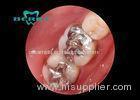

White Gold Alloy Dental Inlays Distinguished Biocompatible Tough
| Place of Origin: | Zhejiang |
|---|
Company Profile
| Location: | Shenzhen, Guangdong, China (Mainland) |
|---|---|
| Business Type: | Manufacturer |
Product Description
White Gold Alloy Dental Inlays Distinguished Biocompatible Tough
Advantages
- Appearance. They have a very attractive natural appearance, unlike silver amalgam and are much less prone to picking up stain and discolouring than white filling materials.The porcelain can not only be shaped to mimic the original tooth, but the patterns of the biting-surface are naturally recreated- with a little staining for added effect.
- Strength: They are not as destructive to the remaining tooth as crowns and by preserving much of the natural tooth, they increase the strength of the tooth.
- Wear: The materials used to make the inlays/ onlays are extremely durable and will wear like fillings, even under the stress of grinding.
- Decay: They are less prone to decay at the margins because of the custom fit and the good seal they achieve.
- Durable: They are more durable and last longer than fillings.
- Hygiene: Because they are custom- made for individual teeth, they do not trap plaque in the same way that poorly done fillings can and thus are easier to keep clean.
- Expansion:They don't expand and contract in the same way as filling materials reducing the stresses on the tooth.
Disadvantages
- Two Visits: Unlike fillings, they require two visits to complete, unless the dentist is using a CEREC or CAD CAM system.
- Cost: They involve a laboratory stage and as such, they are more expensive than the cost of fillings,but are generally cheaper than crowns.
- Wear:Whilst they do not actually wear-out themselves, some of the harder porcelain materials (such as zirconia) run the risk of wearing the opposing natural tooth - especially if the glaze is removed, when the dentist adjusts the bite. This isn't a risk if the inlay/onlay bites on a filling or crown.
- Failure:They can, of course, fail. Generally, this would be a bonding issue and while the cements used are super strong, occasionally they can come off; in which case most of the time, they can simply be re-bonded (provided you still have it!). It is, as with any restoration (crowns, veneers, fillings) also possible for the tooth to get decay at the margins, if there is a problem with the fit or you are not doing your part and keeping it clean.

